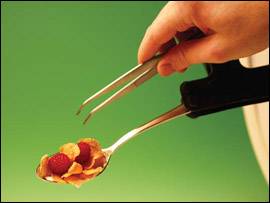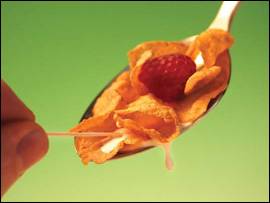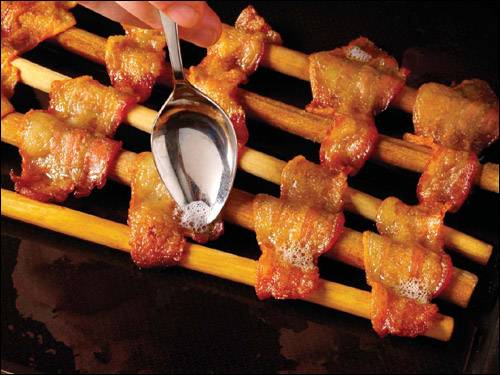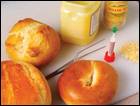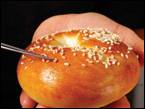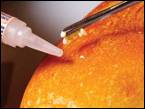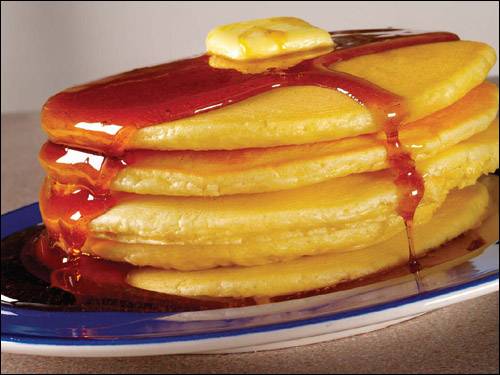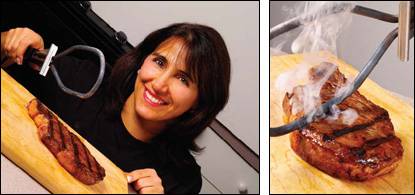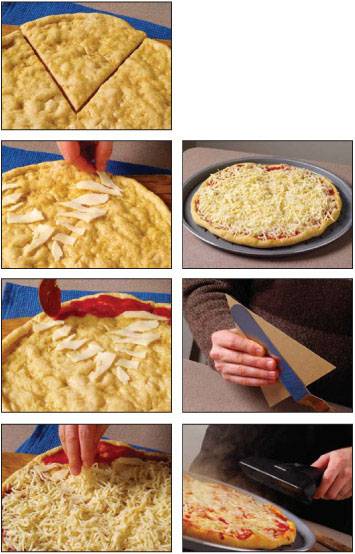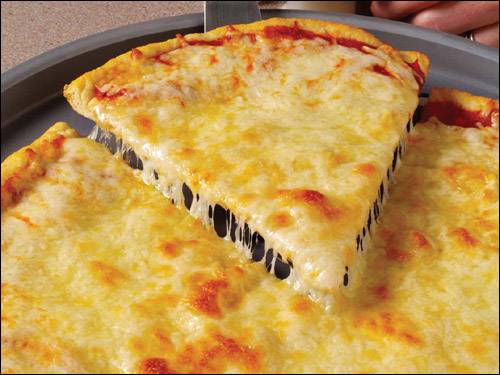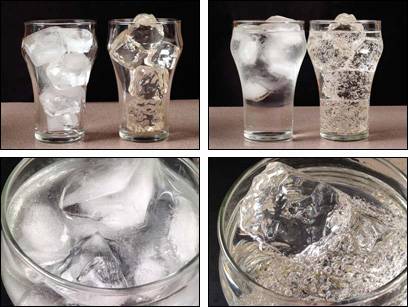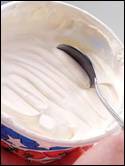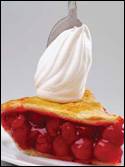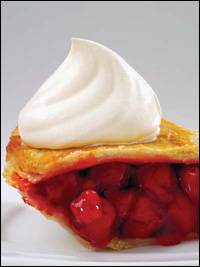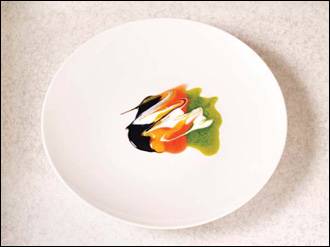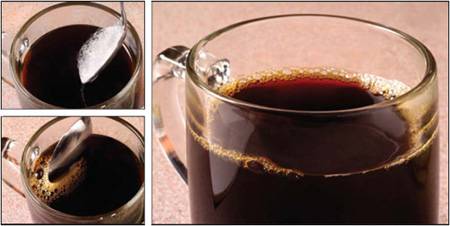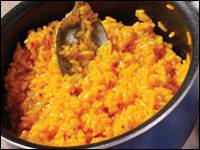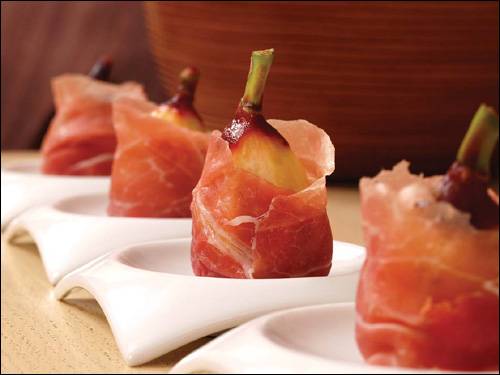Food-Styling Techniques and Tricks
| Food stylists use several techniques to make food look as appetizing as possible, as well as to counteract foods' natural process of discoloration, sagging, dripping, and so forth. For more information, read on! CerealThe secret to a perfect-looking bowl of cereal is a bottle of glue!
Often, when cereal is photographed, the image includes a spoonful. To style a spoonful of cereal, do the following:
BaconBacon is available at many supermarkets in disposable plastic packets that can be cooked in the oven or microwave. Some food stylists prefer to use this product. After cooking the bacon, a great way to keep the strips pliable is to place them in vegetable oil. Perfectly wavy bacon can be achieved by weaving it through the rungs of a wire rack, trimming the strips with scissors where necessary. A modern trick is to use wooden spoons or dowels to create a more natural appearance. To give bacon that "right-out-of-the-frying-pan" appearance, delicately place soapy water on the strips. Seeded Rolls and BagelsSometimes bread, rolls, and bagels do not have enough seeds, and need to be enhanced. There are two primary ways to accomplish this. One method is to spread Vaseline over the area and sprinkle on the seeds. Although Vaseline gives the stylist flexibility in placing and moving seeds, it adds shine to the surface, so many stylists prefer the second method: dabbing an area with Krazy Glue and positioning the seeds individually to keep the original finish. With both methods, a good eye, a pair of tweezers, and a steady hand are essential for seed placement! Pancakes with Butter and SyrupPancakes should be cooked at a very low heat, with little or no fat in the pan, to prevent over-browning. A non-stick pan coated with baking spray works best. Stylists use a combination of light and dark corn syrup or honey in lieu of maple syrup, which is too thin and runny. Years ago, motor oil was used. Kitchen Bouquet, a brown food coloring available in most supermarkets, can be added to achieve a darker appearance. The thicker syrup also gives better control over its placement. If the photograph requires a pat of butter, use margarine; the color is much better. Use a steamer to partially melt the margarine and create the impression that the pancakes are piping hot. Grill MarksTo create the effect of grill marks on food, some stylists use metal skewers heated over an open flame, while others prefer to use an electric charcoal starter. The electric starter makes a wider mark and minimizes your chances of burning yourself. Chicken LegsPreparing chicken legs can be tricky; be sure to make extras in order to get the perfect one. Before cooking them, use T-Pins to hold the skin to the backside of the leg. Do not cook the chicken thoroughly in the oven; doing so will cause the skin to shrink. After they've been cooked, brush Kitchen Bouquet or bitters, a common cocktail ingredient, over the legs to add brown coloring. Fresh HerbsBecause most fresh herbs wilt quickly, it is important to make sure they look alive and healthy for the entire shoot. To revive or freshen the herbs, trim the stems and place the herbs in an ice bath. Dunking the leaves in ice water also helps. A spray bottle filled with water can be used to add droplets to the herbs to give the appearance of dew. PizzaDon't you love a hot, cheesy pizza, fresh from the oven? To style pizza for a shoot, do the following:
BeerThere's nothing that looks more thirst-quenching on a hot summer day than an ice-cold beer with a nice, foamy head. Here's how it's done:
Ice CubesReal ice cubes float to the top of the glass and appear cloudy in photographs. For this reason, food stylists use acrylic ice cubes, which are hand-carved and very expensive. These acrylic cubes show up clear and allow bubbles to appear in the glass, and can be purchased or rented at photographic supply houses. Acrylic ice cubes and many other fabulous fakes are also available online from vendors such as Trengove Studios in New York (http://www.trengovestudios.com). Ice Cream Photographing ice cream is difficult, primarily because it melts quickly. For this reason, fake ice cream is used whenever possible. Some stylists use instant mashed potatoes, while others make their own mixture. Here's a recipe: 1 cup vegetable shortening 1 cup light corn syrup 3 pounds powdered sugar Food coloring, as needed Beat ingredients together in a stand mixer, and store at room temperature. Here are a few tips for working with fake ice cream:
You would never use fake ice cream when shooting for an ice cream company. For a "generic" shot, however, the food stylist and photographer can use real or fake ice cream. Photographers always prefer to use fake ice cream because of its ease of use and longevity. If you must shoot real ice cream, make plenty of scoops in advance and keep them in the freezer until you are ready to use them. Use "stand-in" fake ice cream or some other object that is similar in color and shape for the test shots. Be sure to have a cooler filled with dry ice near the set to keep the ice cream cold and hard between shots. Chocolate Curls Perfectly shaped chocolate curls are an attractive garnish to many desserts. Here's how to make them:
PieA great way to create the effect of a fruit-filled pie is to fill the crust with mashed potatoes and place the actual fruit on top. This enables you to use less fruit filling, and the potatoes prevent the crust from shrinking. To photograph a slice of pie, or pie with a slice removed, do the following:
DollopsIf you're shooting slices of pie, or perhaps an ice-cream sundae, your client may want you to add a dollop of topping. Cool Whip is best for creating dollops. Before you begin, be sure to thaw the Cool Whip completely. Then, with the edge of a tablespoon, make lines across the Cool Whip while it is still in the container. This will create a rippled look when the dollop is made. Use the spoon to scoop out some Cool Whip, and twist the spoon slightly as you apply it to create an interesting peak. "Saucing Up" Your DishTo create a more artistic look for your dish, you can use a tool as simple and commonplace as a plastic squeeze bottle or teaspoon to drizzle sauce. Either tool helps provide control over what is normally a difficult-to-manage ingredient. Think of the plate as a blank canvas, and use your artistic ability to create a design that perfectly complements the main dish. The artistry of a professional food stylist really shines here! Additional TipsHere are a few more food-styling tips:
|



